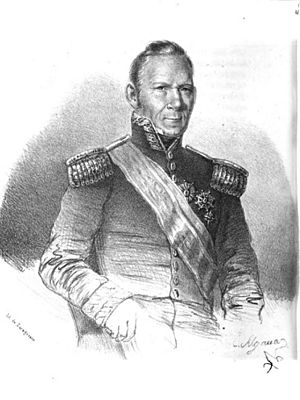Pedro Villacampa facts for kids
Quick facts for kids
Pedro Villacampa
|
|
|---|---|

Portrait, c. 1847
|
|
| Born | 10 May 1776 Laguarta, Huesca, Aragón |
| Died | 27 December 1854 (aged 78) Madrid |
| Battles/wars | War of the Pyrenees War of the Oranges Peninsular War |
Pedro Villacampa Maza de Linaza y Periel (born 1776, died 1854) was a brave Spanish military leader. He is remembered for his actions during important wars in Spain.
Contents
Early Military Life
In 1793, Pedro Villacampa joined the army as a volunteer in Aragón. He quickly moved up the ranks, becoming a second lieutenant in 1795. He fought in the War of the Pyrenees.
After this war, he helped catch smugglers and bandits in areas like Campo de Gibraltar. By 1800, he was promoted to captain for capturing a famous bandit.
He also fought in the War of the Oranges. Later, he was stationed in cities like Zaragoza, Barcelona, and Denia. In 1805, he moved to the Balearic Islands. When he heard about the May Uprising in Spain, he quickly returned to the mainland to help.
Fighting in the Peninsular War
The Peninsular War (1808-1814) was a major conflict where Spain, Portugal, and the United Kingdom fought against Napoleon's French Empire.
1808: Defending Zaragoza
Villacampa joined the 2nd Battalion of Volunteers of Aragón. This group was defending the city of Zaragoza from French attacks. Later that year, he was given command of the 1st Battalion of Volunteers of Huesca.
1809: Rising Through the Ranks
While serving in Zaragoza, Villacampa was sent to defend the Convent of San José. For his bravery, he was promoted to lieutenant colonel. He then defended other key places, like the convent of Santa Mónica. After successfully stopping several attacks, he became a brigadier.
In February 1809, French troops captured him after he was injured. However, he managed to escape before being sent to France.
In March, Villacampa joined General Blake's army. He was promoted to field marshal and sent to Lower Aragon to gather a new division of soldiers. Throughout the summer, he recruited many fighters. He set up his base at the Sanctuary of Our Lady of Fuensanta. Although he was later defeated there by a larger French force, he managed to retreat with many of his troops.
After the fall of Zaragoza and a Spanish defeat at Belchite, the French only controlled Zaragoza and Jaca. The rest of Aragón, especially the mountains, was a good place for guerrilla warfare. Villacampa was one of the key leaders fighting the French in the mountains south of the Ebro river.
1810: Active in Teruel and Beyond
In 1810, Villacampa's division was very active around Teruel. They fought in battles at Villel, Teruel, and Albentosa. In March, he successfully blocked the French army in Teruel, capturing four cannons and about 300 prisoners.
His troops then moved to Calatayud, fighting at El Frasno. The next day, they badly damaged a French column of 350 men near the Xalon river. They returned to Teruel in September. On July 16, 1810, his troops fought at Cariñena.
Villacampa also led combined forces with General Carvajal. They fought as far north as Andorra. Later, their combined forces were pushed back by French troops at Alventosa and Fuensanta.
At the end of 1810, Villacampa's forces joined General Carlos O'Donnell's 2nd Army.
1811: Continued Resistance
On January 11, 1811, Villacampa's division of 6,000 troops was defeated by a French force half its size at Checa. On March 23, 1811, his troops fought alongside el Empecinado's men at Auñón.
1812: Recapturing Towns
After the fall of Valencia in January 1812, Villacampa returned to Aragón. He was very active in March, defeating French forces at Campillo, Ateca, Pozodon, and Monteverde. On October 2, 1812, he recaptured the town of Calatayud. In December, he fought at La Almunia.
Villacampa's actions at Dumeño and Chelva helped block the French general Soult's retreat. For these actions, he became the first person to receive the Laureate Cross of Saint Ferdinand, Spain's highest military decoration.
1813: Governor of Madrid
In 1813, Villacampa was appointed military governor of Madrid. He also became captain general of New Castile, a very important role.
After the War
Around the time King Fernando VII returned to Spain in 1814, Villacampa was promoted to lieutenant general. He was careful because of political tensions.
However, he was later removed from his post in Madrid. He retired to Zaragoza. In 1815, he admitted to supporting the Constitution against King Fernando VII's absolute rule. The king ignored his request for mercy, and Villacampa was sentenced to eight years in prison at Montjuic. He also lost all his military titles and honors.
Four years into his sentence, new accusations came up. But, at the same time, Spain entered a period called the Trienio Liberal (1820-1823), which restored the Constitution. Because of this, Villacampa was released in 1820. He was then appointed captain general of Catalonia. In 1822, he became captain general of Granada, and in 1823, captain general of Andalusia and political governor of Sevilla.
When the "Ominous Decade" began, Villacampa had to leave Spain. He went to Marseille, then Malta, and Tunisia. After King Ferdinand died in 1833, Spain began to change from an absolute monarchy to a constitutional monarchy. Queen Maria Christina offered forgiveness to exiled liberals. Villacampa returned to Spain, and his military rank and honors were given back to him.
Villacampa was then appointed military commander of Minorca until 1838. After that, he became captain general of the Balearic Islands.
In 1843, he was appointed senator for Huesca. He returned to Zaragoza in 1844. In 1845, he was appointed senator for life, a position he held until his death.
See also
 In Spanish: Pedro Villacampa y Maza de Lizana para niños
In Spanish: Pedro Villacampa y Maza de Lizana para niños

